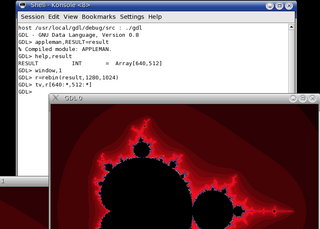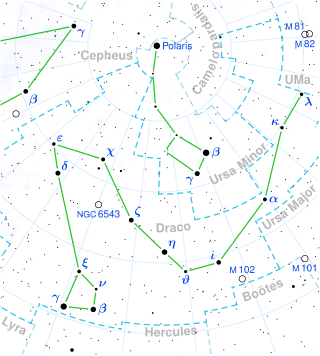
Alpha Phoenicis, formally named Ankaa, with the same pronunciation) is the brightest star in the constellation of Phoenix.

The GNU Data Language (GDL) is a free alternative to IDL, achieving full compatibility with IDL 7 and partial compatibility with IDL 8. Together with its library routines, GDL is developed to serve as a tool for data analysis and visualization in such disciplines as astronomy, geosciences, and medical imaging. GDL is licensed under the GPL. Other open-source numerical data analysis tools similar to GDL include Julia, Jupyter Notebook, GNU Octave, NCAR Command Language (NCL), Perl Data Language (PDL), R, Scilab, SciPy, and Yorick.

Aladin is an interactive software sky atlas, created in France. It allows the user to visualize digitized astronomical images, superimpose entries from astronomical catalogues or databases, and interactively access related data and information from the SIMBAD database, the VizieR service and other archives for all known sources in the field.

CP Lacertae was a nova, which lit up on June 18, 1936 in the constellation Lacerta. It was discovered independently by several observers including Leslie Peltier in the US, E. Loreta in Italy, Włodzimierz Zonn and Kazuaki Gomi, a Japanese barber who discovered the nova during the 19 June 1936 total solar eclipse.

Theta Persei is a star system 37 light years away from Earth, in the constellation Perseus. It is one of the closest naked-eye stars.
HD 11964 is a binary star system located 110 light-years away from the Sun in the equatorial constellation of Cetus. It is visible in binoculars or a telescope but is too faint to be seen with the naked eye, having an apparent visual magnitude of 7.51. The system is drifting closer to the Sun with a radial velocity of −9 km/s. Two extrasolar planets have been confirmed to orbit the primary.

Alberto Conti, is an astrophysicist and the Vice President and General Manager of the Civil Space Strategic Business Unit (SBU) at BAE Systems Inc.. He is one of the creators of the GoogleSky concept, of the idea of astronomical outreach at South by SouthWest 2013 and of the James Webb Space Telescope iBook. He is also the Executive Producer of the Emmy Winning CNN Films The Hunt for Planet B.
HD 126614 is a trinary star system in the equatorial constellation of Virgo. The primary member, designated component A, is host to an exoplanetary companion. With an apparent visual magnitude of 8.81, it is too faint to be seen with the naked eye. The system is located at a distance of 239 light years from the Sun based on parallax measurements, but is drifting closer with a radial velocity of −33 km/s.
HD 175167 is a star with an exoplanet companion in the southern constellation of Pavo. It is too faint to be visible with the naked eye at an apparent visual magnitude of 8.01. The system is located at a distance of 232 light-years from the Sun based on parallax measurements, and it is drifting further away with a radial velocity of 5 km/s. It shows a high proper motion, traversing the celestial sphere at an angular rate of 0.190 arcsec yr−1.

Astroinformatics is an interdisciplinary field of study involving the combination of astronomy, data science, machine learning, informatics, and information/communications technologies. The field is closely related to astrostatistics.

Phi Draconis is a fourth-magnitude variable star in the constellation Draco. It has the Flamsteed designation 43 Draconis. It is also a triple star system where the brightest component is a chemically peculiar Ap star.

Computational astrophysics refers to the methods and computing tools developed and used in astrophysics research. Like computational chemistry or computational physics, it is both a specific branch of theoretical astrophysics and an interdisciplinary field relying on computer science, mathematics, and wider physics. Computational astrophysics is most often studied through an applied mathematics or astrophysics programme at PhD level.

PU Puppis is a class B8III star in the constellation Puppis. Its apparent magnitude is 4.69 and it is approximately 620 light years away based on parallax.

Target is the name of a collaborative research project specialising in big data processing and management in northern Netherlands. It is a public-private cooperation, initiated in 2009 and supported by government subsidies. It is run by a consortium of ten academic and computer industry partners, coordinated by the University of Groningen, and researches data management of science projects in the area of astronomy, life sciences, artificial intelligence and medical diagnosis.
The Astrophysics Source Code Library (ASCL) is an online registry of scientist-written software used in astronomy or astrophysics research. The primary objective of the ASCL is to make the software used in research available for examination to improve the transparency of research.

Astropy is a collection of software packages written in the Python programming language and designed for use in astronomy. The software is a single, free, core package for astronomical utilities due to the increasingly widespread usage of Python by astronomers, and to foster interoperability between various extant Python astronomy packages. Astropy is included in several large Python distributions; it is part of package managers for Linux and macOS, the Anaconda Python Distribution, Enthought Canopy and Ureka.

Alex Szalay is a Bloomberg Distinguished Professor of physics and astronomy and computer science at the Johns Hopkins University School of Arts and Sciences and Whiting School of Engineering. Szalay is an international leader in astronomy, cosmology, the science of big data, and data-intensive computing. In 2023, he was elected to the National Academy of Sciences.
HD 1690 is a giant star with an orbiting exoplanet companion in the constellation of Cetus. It has an apparent visual magnitude of 9.19, which is too faint to be visible to the naked eye. The distance to this system is approximately 2,570 light years, and it is drifting further away with a radial velocity of +18.2 km/s. HD 1690 has no known companion star, making it a single star system.













